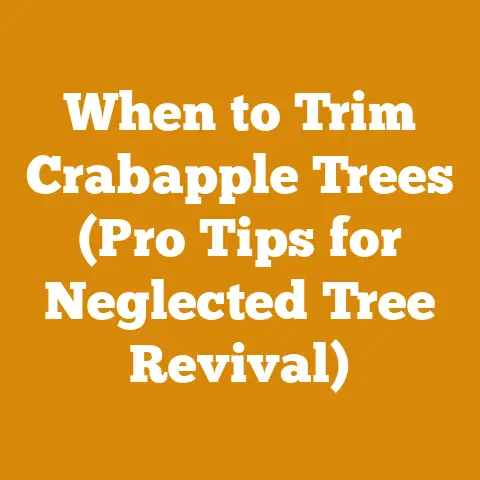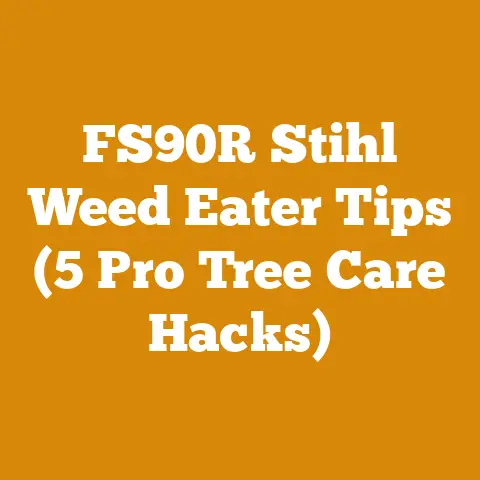Dying Birch Tree Guide (5 Signs Every Arborist Should Know)
Birch trees, with their elegant white bark and graceful form, are often a favorite in landscapes.
They are generally easy to care for when planted in the right conditions.
However, even with proper care, birch trees can be susceptible to various diseases and environmental stressors.
Recognizing the signs of a dying birch tree is crucial for any arborist, homeowner, or anyone who appreciates these beautiful trees.
Early detection can allow for intervention and potentially save the tree.
Dying Birch Tree Guide: 5 Signs Every Arborist Should Know
As someone deeply involved in wood processing and firewood preparation, I’ve seen firsthand the impact of tree health on the quality and usability of the wood.
A dying birch tree not only loses its aesthetic appeal but also becomes a liability, potentially harboring pests and diseases that can spread to other trees.
In this guide, I’ll share five critical signs that indicate a birch tree is declining, along with my insights on the cost implications and how to address them.
1. Canopy Dieback and Thinning
One of the first signs of a birch tree in distress is canopy dieback and thinning.
This refers to the progressive death of branches from the tips inward, resulting in a sparser canopy.
- What to Look For: Look for branches that are bare at the ends, with fewer leaves than usual.
The leaves that are present might be smaller, discolored, or prematurely dropping. - The Culprit: This can be caused by a variety of factors, including birch borer infestations, fungal diseases like bronze birch borer, drought stress, or nutrient deficiencies.
Cost Implications: Canopy dieback significantly impacts the quality of the wood.
The affected branches become brittle and prone to breakage, making them unsuitable for most woodworking projects.
If the tree is harvested for firewood, the dead branches will burn quickly but provide minimal heat.From my experience, a tree with significant canopy dieback yields about 30% less usable wood compared to a healthy tree.
This translates to a direct loss in revenue for firewood suppliers or increased costs for homeowners who need to purchase additional firewood.
* Addressing the Issue:- Pruning: Remove dead and diseased branches to prevent the spread of infection.
Be sure to sanitize your pruning tools between cuts to avoid further contamination. - Watering: Ensure the tree receives adequate water, especially during dry periods.
Birch trees prefer moist, well-drained soil. - Fertilizing: Conduct a soil test to determine any nutrient deficiencies and amend the soil accordingly.
- Pest Control: If birch borers are the cause, consider insecticide treatments or systemic injections to protect the tree.
This can cost anywhere from $100 to $500 depending on the size of the tree and the severity of the infestation.
- Pruning: Remove dead and diseased branches to prevent the spread of infection.
2. Bark Abnormalities: Cracks, Lesions, and Discoloration
The bark of a birch tree is one of its most distinguishing features.
Any abnormalities in the bark can be a red flag.
- What to Look For: Inspect the bark for cracks, lesions, cankers (sunken or swollen areas), and unusual discoloration.
Look for signs of insect activity, such as small holes or sawdust-like material. - The Culprit: Bark abnormalities can be caused by fungal diseases, insect infestations, mechanical damage, or environmental stress.
Bronze birch borers, for instance, create characteristic D-shaped exit holes in the bark. Cost Implications: Bark damage can compromise the structural integrity of the tree, making it more susceptible to windthrow (being uprooted by wind).
If the tree is located near a building or power lines, the cost of removing a fallen tree can be substantial, potentially ranging from $500 to several thousand dollars, depending on the complexity of the removal.Moreover, the presence of bark abnormalities can significantly reduce the value of the wood.
The damaged areas may be unusable, and the overall quality of the wood can be compromised.
* Addressing the Issue:- Consult an Arborist: A professional arborist can diagnose the cause of the bark abnormalities and recommend the appropriate treatment.
- Wound Treatment: If the damage is minor, you can try cleaning the affected area and applying a wound dressing to promote healing.
- Pest Control: If insects are the cause, consider insecticide treatments or other pest control methods.
- Tree Removal: In severe cases, where the bark damage is extensive and the tree is structurally unstable, removal may be the only option.
3. Fungal Growth: Mushrooms and Conks
The presence of mushrooms or conks (shelf-like fungal growths) on a birch tree is a clear indication of internal decay.
- What to Look For: Look for mushrooms growing at the base of the tree or conks attached to the trunk or branches.
These fungal growths are the fruiting bodies of fungi that are actively decaying the wood inside the tree. - The Culprit: Fungal decay is caused by various species of fungi that enter the tree through wounds or other openings in the bark.
These fungi break down the lignin and cellulose in the wood, weakening its structure. Cost Implications: Fungal decay significantly reduces the value of the wood.
The decayed areas are unusable, and the overall quality of the wood is compromised.
In severe cases, the tree may become structurally unstable and pose a safety hazard.From my experience, a tree with significant fungal decay is often unsuitable for firewood.
The decayed wood burns poorly and produces excessive smoke.
Moreover, the presence of fungal decay can increase the cost of tree removal, as the tree may be more difficult to handle and dispose of safely.
* Addressing the Issue:- Consult an Arborist: A professional arborist can assess the extent of the fungal decay and recommend the appropriate course of action.
- Tree Removal: In most cases, a tree with significant fungal decay will need to be removed to prevent it from falling and causing damage or injury.
- Prevention: Prevent fungal decay by protecting the tree from wounds and other injuries.
Avoid damaging the bark with lawnmowers or other equipment.
4. Leaf Spot and Discoloration
While some leaf discoloration is normal in the fall, premature or unusual leaf spot and discoloration can indicate a problem.
- What to Look For: Look for leaves with spots, blotches, or unusual discoloration.
The leaves may turn yellow, brown, or black prematurely. - The Culprit: Leaf spot and discoloration can be caused by fungal diseases, bacterial infections, or nutrient deficiencies.
Anthracnose, for example, is a common fungal disease that causes irregular brown spots on birch leaves. Cost Implications: Leaf spot and discoloration can weaken the tree, making it more susceptible to other diseases and pests.
In severe cases, it can lead to premature leaf drop and reduced growth.From a wood processing perspective, a tree with significant leaf spot and discoloration may produce wood that is lower in quality.
The tree’s overall health is compromised, which can affect the density and strength of the wood.
* Addressing the Issue:- Fungicide Treatments: If the leaf spot is caused by a fungal disease, consider fungicide treatments to protect the tree.
- Fertilizing: Conduct a soil test to determine any nutrient deficiencies and amend the soil accordingly.
- Watering: Ensure the tree receives adequate water, especially during dry periods.
- Pruning: Remove any dead or diseased branches to prevent the spread of infection.
5. Stunted Growth and Reduced Vigor
A general decline in growth and vigor is a telltale sign of a tree in distress.
- What to Look For: Look for reduced annual growth, smaller leaves, and a general lack of vitality.
The tree may appear weak and stressed. - The Culprit: Stunted growth and reduced vigor can be caused by a variety of factors, including soil compaction, root damage, nutrient deficiencies, drought stress, or pest infestations.
Cost Implications: A tree with stunted growth and reduced vigor will produce less wood and of lower quality.
The tree’s overall health is compromised, which can affect the density, strength, and appearance of the wood.From a firewood perspective, a tree with reduced vigor may produce wood that is less dense and burns less efficiently.
This translates to a lower heat output and a higher consumption rate.
* Addressing the Issue:- Soil Improvement: Improve soil drainage and aeration to promote root growth.
- Fertilizing: Conduct a soil test to determine any nutrient deficiencies and amend the soil accordingly.
- Watering: Ensure the tree receives adequate water, especially during dry periods.
- Pest Control: If pests are the cause, consider insecticide treatments or other pest control methods.
- Root Care: Avoid damaging the roots of the tree with lawnmowers or other equipment.
Understanding the Costs Associated with Dying Birch Trees
Dealing with a dying birch tree involves various costs, from diagnosis and treatment to removal and replacement.
Here’s a breakdown of the potential expenses:
- Arborist Consultation: A consultation with a certified arborist typically costs between $75 and $200 per hour.
This includes a thorough assessment of the tree’s health, diagnosis of the problem, and recommendations for treatment. - Treatment Costs: Treatment costs vary depending on the cause of the decline.
Insecticide treatments for birch borers can range from $100 to $500 per application, while fungicide treatments for leaf spot can cost between $50 and $200 per application.
Soil amendments and fertilization can cost between $50 and $300, depending on the size of the tree and the extent of the nutrient deficiencies. - Tree Removal: Tree removal costs vary depending on the size and location of the tree, as well as the complexity of the removal.
A small birch tree (less than 30 feet tall) can typically be removed for $150 to $500, while a large birch tree (over 60 feet tall) can cost between $500 and $2,000 or more.
If the tree is located near power lines or buildings, the cost of removal can be significantly higher. - Stump Removal: Stump removal is an additional cost that is often overlooked.
Stump grinding typically costs between $2 and $5 per inch of stump diameter.
For example, a 24-inch stump would cost between $48 and $120 to grind. - Replacement Costs: Replacing a dying birch tree with a new one can cost between $100 and $500, depending on the size and species of the tree.
Planting costs can add another $50 to $200 to the total expense.
Budgeting for Birch Tree Care and Removal
Creating a budget for birch tree care and removal is essential for managing costs effectively.
Here are some tips for developing a realistic budget:
- Get Multiple Quotes: Obtain quotes from several arborists and tree removal companies before making a decision.
Compare the prices and services offered by each company to ensure you are getting the best value for your money. - Prioritize Treatments: If you are on a tight budget, prioritize treatments that will have the greatest impact on the tree’s health.
For example, controlling birch borers may be more important than treating leaf spot. - Consider DIY Options: Some tree care tasks, such as watering and fertilizing, can be done yourself to save money.
However, it is important to consult with an arborist before attempting any treatments on your own. - Plan Ahead: Don’t wait until the tree is in critical condition before taking action.
Early detection and treatment can often prevent costly tree removal. - Factor in Contingency Funds: Always include a contingency fund in your budget to cover unexpected expenses.
Tree care and removal can be unpredictable, so it is important to have a buffer in case something goes wrong.
Case Studies: Real-World Examples of Birch Tree Management Costs
To illustrate the cost implications of dealing with dying birch trees, let’s examine a few case studies:
Case Study 1: Birch Borer Infestation
A homeowner in Minnesota noticed that their 40-foot birch tree was experiencing canopy dieback and thinning.
Upon closer inspection, they discovered D-shaped exit holes in the bark, indicating a birch borer infestation.
- Cost Breakdown:
- Arborist Consultation: \$100
- Insecticide Treatment: \$300 (two applications)
- Pruning: \$200
- Total Cost: \$600
The homeowner was able to save the tree by promptly addressing the birch borer infestation.
However, if they had waited longer, the tree may have become too damaged to save, resulting in the need for costly tree removal.
Case Study 2: Fungal Decay
A firewood supplier in Maine discovered that several of their birch trees were exhibiting signs of fungal decay.
Mushrooms were growing at the base of the trees, and the wood was soft and spongy.
- Cost Breakdown:
- Arborist Consultation: \$150
- Tree Removal: \$500 (per tree)
- Stump Removal: \$100 (per stump)
- Lost Revenue: \$200 (per tree, due to unusable wood)
- Total Cost: \$950 (per tree)
The firewood supplier was forced to remove the infected trees to prevent the spread of fungal decay to other trees.
They also incurred a loss of revenue due to the unusable wood.
Case Study 3: Drought Stress
A homeowner in Colorado experienced a prolonged drought, which caused significant stress to their birch tree.
The tree exhibited leaf spot, discoloration, and stunted growth.
- Cost Breakdown:
- Arborist Consultation: \$75
- Soil Amendment: \$100
- Deep Root Watering: \$150
- Fertilizing: \$50
- Total Cost: \$375
The homeowner was able to improve the health of the tree by addressing the drought stress.
They amended the soil, provided deep root watering, and fertilized the tree.
Industry Benchmarks and Statistical Data
To provide a better understanding of the costs associated with wood processing and firewood preparation, here are some industry benchmarks and statistical data:
- Average Price per Cord of Firewood: The average price per cord of firewood in the United States ranges from $150 to $400, depending on the location, wood species, and seasoning.
- Timber Prices: Timber prices vary depending on the species, quality, and location.
According to the USDA Forest Service, the average stumpage price for hardwood timber in the United States in 2023 was $75 per thousand board feet. - Equipment Rental Fees: Equipment rental fees for wood processing and firewood preparation vary depending on the type of equipment and the rental period.
A chainsaw can typically be rented for $30 to $50 per day, while a log splitter can be rented for $50 to $100 per day. - Labor Wages: Labor wages for logging crews and firewood handlers vary depending on the location and experience level.
According to the Bureau of Labor Statistics, the median annual wage for logging workers in the United States in May 2022 was $46,840.
Practical Tips for Cost Optimization
Here are some practical tips for optimizing costs in wood processing and firewood preparation projects:
- Choose the Right Wood Species: Different wood species have different heating values and burn characteristics.
Choose a wood species that is readily available and provides good heat output for your needs.
Birch, while beautiful, might not be the most cost-effective choice in all regions. - Season Firewood Properly: Properly seasoned firewood burns more efficiently and produces less smoke.
Allow firewood to dry for at least six months before burning it. - Maintain Your Equipment: Regularly maintain your chainsaws, log splitters, and other equipment to ensure they are operating efficiently.
This will help you avoid costly repairs and downtime. - Shop Around for Supplies: Compare prices from different suppliers before purchasing wood, equipment, or other supplies.
- Consider DIY Options: Some wood processing and firewood preparation tasks, such as splitting and stacking firewood, can be done yourself to save money.
Actionable Takeaways and Next Steps
Recognizing the signs of a dying birch tree is the first step in protecting your investment and preventing potential safety hazards.
Here are some actionable takeaways and next steps:
- Regularly Inspect Your Birch Trees: Conduct regular inspections of your birch trees for signs of decline, such as canopy dieback, bark abnormalities, fungal growth, leaf spot, and stunted growth.
- Consult with a Certified Arborist: If you notice any signs of decline, consult with a certified arborist to diagnose the problem and recommend the appropriate treatment.
- Develop a Budget for Tree Care and Removal: Create a budget for tree care and removal to manage costs effectively.
- Take Action Promptly: Don’t wait until the tree is in critical condition before taking action.
Early detection and treatment can often prevent costly tree removal. - Consider the Cost Implications: Understand the cost implications of dealing with dying birch trees, including the cost of diagnosis, treatment, removal, and replacement.
By following these steps, you can protect your birch trees, manage costs effectively, and ensure the safety of your property.
Remember, a healthy tree is not only a beautiful asset but also a valuable resource for wood processing and firewood preparation.






